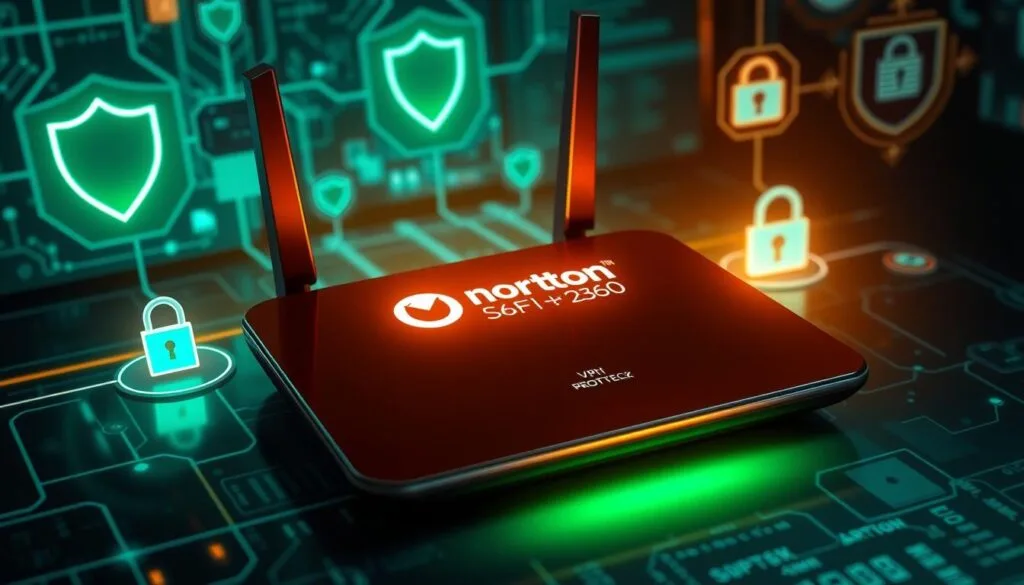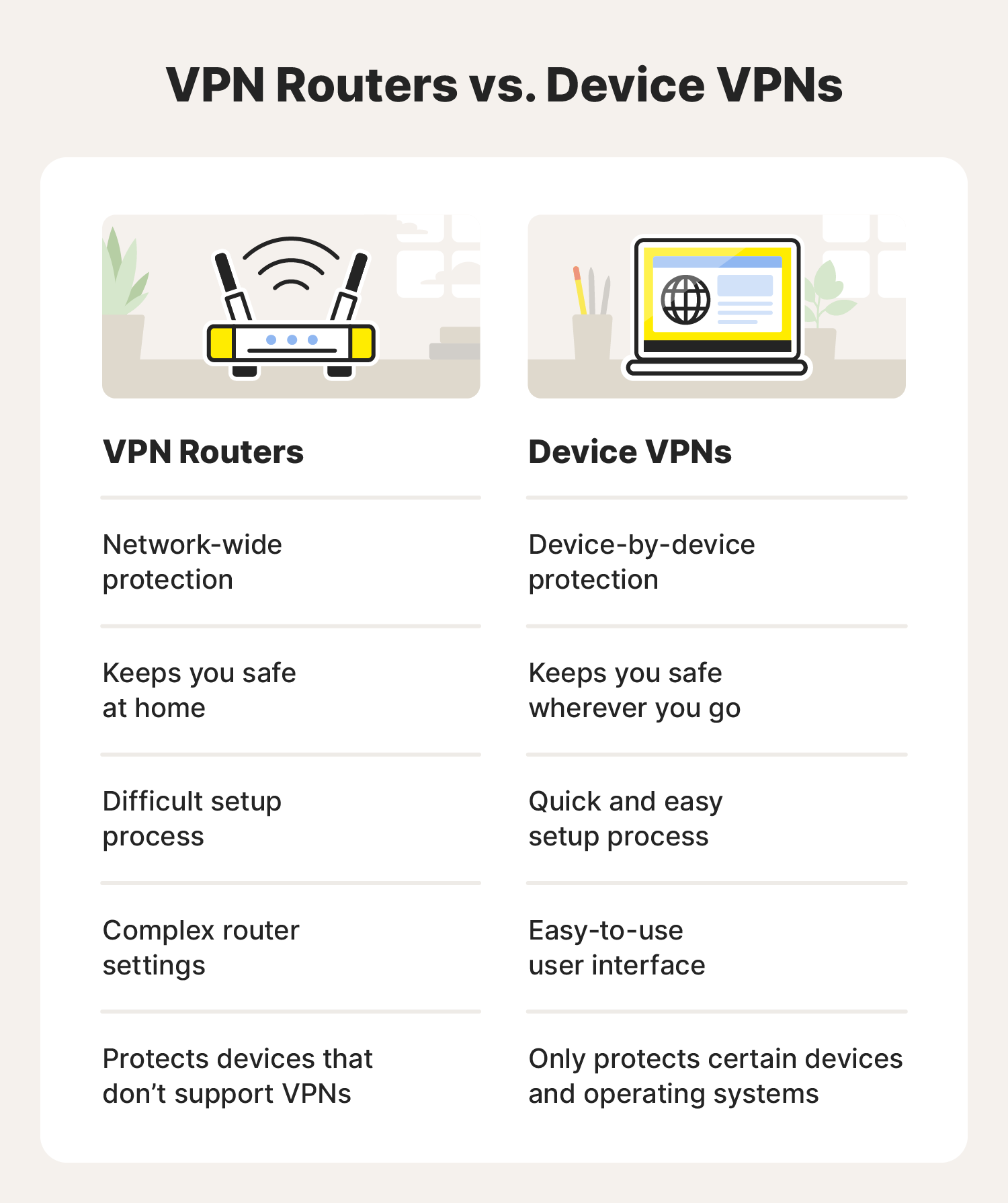Adding a VPN to your WiFi router enhances your online security. It protects all devices connected to your network.
To do this with Norton 360, follow a few simple steps. In today’s digital world, online privacy is crucial. A VPN, or Virtual Private Network, keeps your internet activity secure. By adding a VPN to your WiFi router, you ensure all connected devices benefit from this security.
Norton 360 offers a reliable VPN service that integrates well with routers. This guide will show you how to add a VPN to your WiFi router using Norton 360. Whether you are tech-savvy or a beginner, you can follow these steps. Protect your entire network and browse safely. Let’s get started!

Credit: www.solu-techs.com
Requirements
To add a VPN to your Wi-Fi router with Norton 360, you need specific hardware and software. Ensuring you have these requirements will streamline the setup process.
Necessary Hardware
First, you need a compatible Wi-Fi router. Not all routers support VPNs. Check your router’s manual or the manufacturer’s website to confirm VPN compatibility.
| Hardware | Description |
|---|---|
| Wi-Fi Router | Must support VPN configuration |
| Ethernet Cable | For connecting your computer to the router during setup |
| Computer or Laptop | For accessing the router’s settings |
You also need an ethernet cable. This connects your computer to the router during setup. A computer or laptop is essential. It’s used to access and configure the router’s settings.
Software Prerequisites
Ensure you have Norton 360 installed. It includes the VPN feature. A stable internet connection is also necessary for downloading any required firmware updates.
- Norton 360 Software
- Stable Internet Connection
- Router Firmware (latest version)
Updating your router firmware is crucial. It ensures compatibility and security. Check the router manufacturer’s website for the latest firmware version.
Having these requirements ready will make the process smooth and efficient. Your VPN setup will be more secure and reliable.
Setting Up Norton 360
Adding a VPN to your WiFi router using Norton 360 ensures your online activities remain private and secure. Setting up Norton 360 is a straightforward process. This guide will help you install and activate the VPN service on your router.
Installing Norton 360
First, ensure you have a valid Norton 360 subscription. If you don’t, you can purchase one from the Norton website. Follow these steps to install Norton 360:
- Download the Norton 360 installer from the official website.
- Run the installer and follow the on-screen instructions.
- Enter your product key when prompted.
- Complete the installation by clicking ‘Finish’.
Once installed, Norton 360 will automatically update to the latest version. This ensures you have the most recent security features.
Activating Vpn Service
After installing Norton 360, the next step is to activate the VPN service. Follow these steps:
- Open Norton 360 on your computer.
- Click on the ‘Secure VPN’ tab.
- Click ‘Turn On’ to enable the VPN service.
- Choose a server location from the list provided.
- Ensure the VPN is connected and running.
With the VPN activated, your internet traffic is encrypted. This keeps your data safe from prying eyes.
To connect your WiFi router to the VPN, follow the router’s specific instructions. Generally, this involves entering the VPN details into the router’s settings.
If you face any issues, refer to the Norton support page for troubleshooting tips. Remember to keep your Norton 360 software up to date to enjoy continuous protection.
Configuring The Router
Setting up a VPN on your WiFi router with Norton 360 can seem daunting. Yet, it is a straightforward process with the right guidance. This section will walk you through the steps to configure your router effectively.
Accessing Router Settings
First, you need to access your router’s settings. Follow these steps:
- Connect your computer to the router via WiFi or Ethernet cable.
- Open your web browser and type the router’s IP address in the address bar.
- Common IP addresses include 192.168.1.1 or 192.168.0.1.
- Press Enter. You will see a login page.
- Enter the router’s username and password. Default credentials are often admin for both fields.
- Click Login to access the router settings.
Enabling Vpn On Router
Once inside the router settings, you can enable the VPN:
- Navigate to the VPN or Security section in the router settings.
- Select the option to add a new VPN connection.
- Input the required VPN settings provided by Norton 360. This usually includes:
- VPN server address
- VPN protocol
- Username and Password
- Save the settings and apply the changes.
- Restart your router to ensure the VPN settings take effect.
After completing these steps, your router should be configured with the Norton 360 VPN. This will protect all devices connected to your WiFi network.
Connecting Vpn To Router
Connecting a VPN to your router can enhance your online privacy. It helps secure all devices connected to your WiFi network. Norton 360 offers a reliable VPN service. Follow these steps to connect it to your router.
Inputting Vpn Details
First, access your router settings. Open a web browser and enter your router’s IP address. Log in using your username and password.
Next, find the VPN section in your router’s settings. This could be under “Advanced Settings” or “Network Settings.” Select “Add a VPN” or a similar option. Now, input the VPN details from Norton 360. This includes the server address, username, and password.
Saving And Applying Settings
After entering the VPN details, save the settings. Look for a “Save” or “Apply” button in the VPN section. Click it to save your changes.
Finally, restart your router. This helps apply the new VPN settings. Once the router restarts, all connected devices will use the Norton 360 VPN. Your network is now more secure.
Testing The Connection
Once you have added a VPN to your WiFi router using Norton 360, it is essential to ensure the connection is active and working correctly. This step involves a few simple checks to verify the VPN is functioning as intended and to troubleshoot any common issues that may arise.
Verifying Vpn Connection
First, confirm that the VPN is connected. Follow these steps:
- Open a web browser on any device connected to your WiFi network.
- Visit an IP-checking website, such as whatismyipaddress.com.
- Check your IP address. If the VPN is working, the IP should reflect a different location.
Also, try accessing content that is region-specific. For example, access a streaming service available only in the VPN location. This confirms the VPN is routing your traffic correctly.
Troubleshooting Common Issues
If your VPN connection is not working, consider the following common issues and solutions:
- Incorrect VPN Settings: Double-check the VPN settings on your router. Ensure all details match the VPN service’s requirements.
- Internet Connection: Ensure your internet connection is stable. A weak connection can disrupt the VPN.
- VPN Service Status: Check the VPN provider’s status page. Sometimes, service outages cause connection issues.
- Firmware Update: Update your router’s firmware. This can resolve compatibility issues with the VPN.
By following these steps, you can ensure your VPN is correctly set up and troubleshoot any problems that arise.

Credit: community.norton.com
Enhancing Security
Enhancing security on your WiFi router with Norton 360 is essential. A VPN on your router adds an extra layer of protection. This ensures all connected devices are safe from online threats.
Setting Up Firewall
Start by enabling the firewall on your Norton 360. This blocks unauthorized access to your network. Open Norton 360 and navigate to the firewall settings. Ensure the firewall is active and configured correctly.
Check the rules and settings. Make sure they are optimized for your needs. A strong firewall is the first step in securing your network.
Configuring Additional Security Features
Norton 360 offers various security features. Enable these to enhance protection. One important feature is the intrusion prevention system. This monitors your network for suspicious activity.
Another feature is the Safe Web. It protects you from phishing sites and harmful downloads. Make sure all these features are turned on and updated.
Regularly update your Norton 360 software. Updates provide the latest security patches and features. Keeping your software updated ensures maximum protection.
Maintaining Your Vpn
Once you have set up your VPN with Norton 360 on your WiFi router, it is important to maintain it. Regular maintenance ensures that your VPN continues to protect your online activities. Below are the essential steps to maintain your VPN effectively.
Regular Updates
Ensure your VPN software is always up-to-date. Updates often include security patches and performance improvements. Keeping your VPN updated helps protect against new threats. Here’s how you can keep your VPN updated:
- Enable auto-updates in the Norton 360 settings.
- Manually check for updates in the Norton 360 dashboard.
- Subscribe to Norton alerts for the latest update notifications.
Monitoring Vpn Performance
Regularly monitor the performance of your VPN to ensure it is functioning correctly. Monitoring helps identify any issues early. Here are some tips for effective monitoring:
- Check connection speeds periodically.
- Ensure the VPN is connected at all times.
- Look for any unusual activity or alerts in the Norton dashboard.
By following these steps, you can maintain your VPN and ensure your online privacy. Regular updates and performance monitoring are key. They help keep your connection secure and reliable.

Credit: us.norton.com
Frequently Asked Questions
How Do I Set Up A Vpn On My Router?
To set up a VPN on your router, access your router’s settings, usually through a web browser. Enter the VPN configuration details provided by your VPN service. Save the settings and reboot your router.
Does Norton 360 Support Vpn On Routers?
Yes, Norton 360 supports VPN configuration on routers. You need to use the VPN settings provided by Norton 360. Access your router’s setup page, enter the VPN settings, and apply the changes.
Can I Use Norton 360 Vpn On Multiple Devices?
Yes, you can use Norton 360 VPN on multiple devices. Once configured on your router, all connected devices will benefit from VPN protection. This provides an added layer of security for every device connected to your network.
Why Should I Add A Vpn To My Router?
Adding a VPN to your router enhances your network security. It encrypts all data traffic, protecting your privacy and bypassing geo-restrictions. This is especially useful for devices that don’t support VPN apps directly.
Conclusion
Adding a VPN to your WiFi router with Norton 360 is simple. Follow the steps carefully. Ensure your router supports VPN. This setup boosts security and privacy. Enjoy safer internet browsing. Protect your devices from threats. No need for complicated tech knowledge.
Norton 360 makes it user-friendly. Your data stays safe and private. Now, experience worry-free online activities. Happy browsing!
